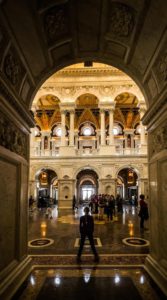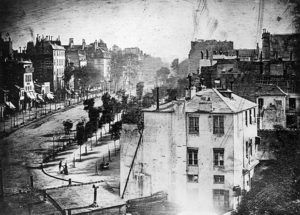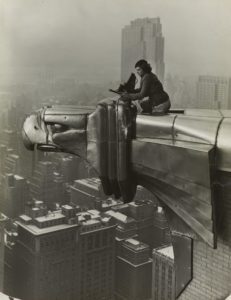If you missed this passed meeting, you missed a doozy. Sure, you’ll have this blog to refer to, but there can be no comparison.
We started the night by dropping off prints for General (to be judged on March 20). After that, Peter Baiamonte spoke about the topic he’ll be judging (Cityscapes) with enough enthusiasm that Howie Levitz (our judge from Portraiture) stopped by to watch. I thought he was lost. Two judges at one meeting!
Baiamonte discussed Urban and Street photography at great length, starting with the very first known photograph of a person. No, seriously. In the lower left of this photo, you can see someone getting their shoes shined. The exposures were so long back then that everyone else in the shot is invisible since they were moving.
The discussion gradually explored different styles of Urban photography through the years. The consensus is that Urban photography covers everything from a fully cityscape showing hundreds of buildings, all the way down to close-up street photography of a person walking down stairs. It needs to clearly be about the city (or town). Buildings and people. That’s a good chunk of it, but there’s more.
Buildings are buildings, no matter how old a photo is, but moments show distinction that last. Whereas you can do city photography without people, what is a city without people? An empty shell? Consider the photo of female photographer Margaret Bourke White on top of a gargoyle on the Chrysler Building. Now imagine this same photo without her in it… The image would still contain the same buildings, the same gargoyle head, the same awesome height, but without the human element it wouldn’t be nearly as iconic a shot. Even today, you can go to the Chrysler Building and view this exact same gargoyle head, but you’ll never capture that same moment. That’s what makes the photo unique.
As photographers, most of us are introverts. We don’t like people. We get skittish about taking photos of people. Especially strangers. Do you shoot first and ask questions later? Do you ask first and risk getting told no? Well…
- In a public space, there is a limited expectation of privacy. For non-commercial purposes, you can take the picture. It’s up to you to decide whether or not you should.
- If you’re at a fair distance, people may not even realize they’re in your shot and you likely won’t disturb them.
- If you’re closer to them or they obviously see you, ask. We often worry about “ruining the moment” by asking. It won’t be as candid. But by being in close quarters with them and pointing a camera in their face, you’re probably going to ruin the moment anyway (or create an unexpected moment).
- Asking permission can be as simply raising your camera so they can see it and tilting your head. Or pointing at the camera. Most people will get what these gestures mean.
- If they say no, respect it and move on.
- It can be easier to people when you’re a tourist, rather than when you’re in your hometown.
- If you’re worried about being too conspicuous, stop being so self-conscious consider your gear. If you show up with a full frame camera on a tripod, paired with a large studio strobe, and a lens that requires its own tripod socket, everyone is going to be wary of you. If you show up with a smartphone, you’re just part of the mindless zombie horde crowd.
 Journalistic and Documentary styles of photography were mentioned, but Baiamonte looked at other styles as well. Shooting through water droplets on a window, use of saturated colors, experimenting with perspectives, reflections, etc… Creativity! Last year, there were an estimated 1.3 trillion photos taken. 700 billion of these were of cats. If you’re shooting in Times Square, consider the millions (billions?) of photos taken from the exact spot you are standing. How is your photo going to be different than all the rest? Well, if you think creatively and wait for special moments, you’re probably off to a good start.
Journalistic and Documentary styles of photography were mentioned, but Baiamonte looked at other styles as well. Shooting through water droplets on a window, use of saturated colors, experimenting with perspectives, reflections, etc… Creativity! Last year, there were an estimated 1.3 trillion photos taken. 700 billion of these were of cats. If you’re shooting in Times Square, consider the millions (billions?) of photos taken from the exact spot you are standing. How is your photo going to be different than all the rest? Well, if you think creatively and wait for special moments, you’re probably off to a good start.- Jay Maisel – Well, his website is under construction (talk about missing the moment), but HERE you can find some examples of his work. He’s great about capturing moments, but look at those vibrant colors. He says, “I’m trying not to look for anything — I’m trying to have it come to me.” It is clear by some of his photos, he looked for locations, then had the moment come to him.
- Martin Parr – A British photographer with a great eye and a humorous slant to his artwork. He finds the quirky things people do. (playing chess in a hot spring, crowds trying to balance the Leaning Tower of Pisa, etc…) HERE is some more of his work. I’m rather a fan of his taken on the Leaning Tower of Pisa.
- Saul Leiter – “Perfection is not something I admire. A touch of confusion is a desirable ingredient.” He often obscures part of the image. Fog, umbrellas, hats, shadows, etc… By blocking out part of what’s going on, he lures your eyes to where he wants your focus. Or sometimes, makes you focus on what’s missing. He did not have a website I could find, so have a link to 7 Lessons Saul Leiter Has Taught Me About Street Photography.



Excellent summary John…. as usual.